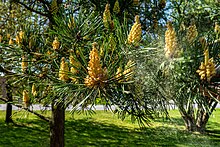Anemophily
Anemophily or wind pollination is a form of
Syndrome

Features of the wind-pollination syndrome include a lack of scent production, a lack of showy floral parts (resulting in small, inconspicuous flowers), reduced production of nectar, and the production of enormous numbers of pollen grains.[4] This distinguishes them from entomophilous and zoophilous species (whose pollen is spread by insects and vertebrates respectively).[citation needed]
Anemophilous
Anemophily is an adaptation that helps to separate the male and female reproductive systems of a single plant, reducing the effects of inbreeding.[6] It often accompanies dioecy – the presence of male and female reproductive structures on separate plants.[citation needed] Anemophily is adaptively beneficial because it promotes outcrossing and thus the avoidance of inbreeding depression that can occur due to the expression of recessive deleterious mutations in inbred progeny plants[7].
Allergies
Almost all pollens that are allergens are from anemophilous species.[8] People allergic to the pollen produced by anemophilous plants often have symptoms of hay fever.[2] Grasses (Poaceae) are the most important producers of aeroallergens in most temperate regions, with lowland or meadow species producing more pollen than upland or moorland species.[8] In Morocco, it was found that asthma caused by pollen from Poaceae accounted for 10% of the clinical respiratory diseases that patients faced.[9] The nature of how species of Poaceae grasses flower results in an increase in the time that the allergenic pollen circulates through the air, which is not favorable to people who are hypersensitive to it.[9]
References
- ^ ISBN 9788170249245.
- ^ a b c d e f Resources, University of California, Division of Agriculture and Natural. "Wind". ucanr.edu. Retrieved 2020-12-01.
{{cite web}}: CS1 maint: multiple names: authors list (link) - ^ a b "Wind Pollination". seeds.ca. Retrieved 2020-12-15.
- ISBN 9780851997056.
- ^ a b "Wind and Water Pollination". www.fs.fed.us. Retrieved 2020-12-15.
- .
- ^ Charlesworth D, Willis JH. The genetics of inbreeding depression. Nat Rev Genet. 2009 Nov;10(11):783-96. doi: 10.1038/nrg2664. PMID: 19834483
- ^ ISBN 9781444300925.
- ^ ISSN 1573-3025.
External links
 Media related to Wind pollination at Wikimedia Commons
Media related to Wind pollination at Wikimedia Commons
